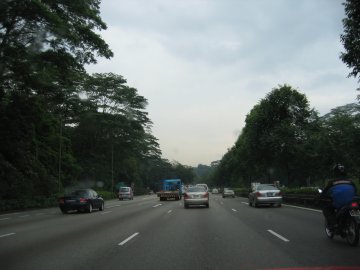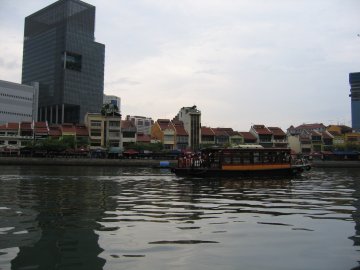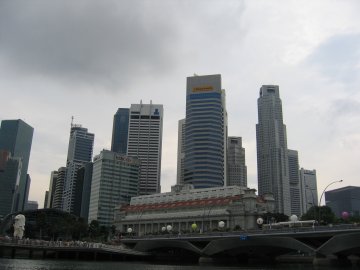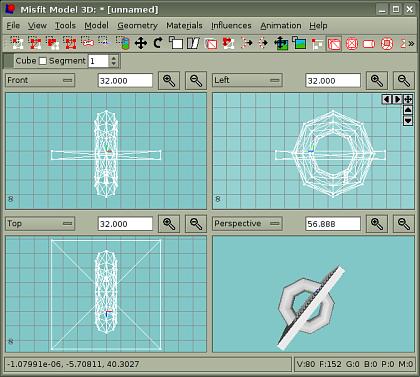Hari's Corner
Humour, comics, tech, law, software, reviews, essays, articles and HOWTOs intermingled with random philosophy now and thenA review of Hari's Corner
Filed under:
Bits and Bytes by
Hari
Posted on Wed, Aug 22, 2007 at 17:54 IST (last updated: Wed, Jul 16, 2008 @ 20:24 IST)
Our Singapore visit
Filed under:
Life and Leisure by
Hari
Posted on Mon, Aug 20, 2007 at 14:25 IST (last updated: Wed, Oct 29, 2008 @ 21:40 IST)
 )
)
The flight from Chennai
First things first: I hate flying, I hate aircrafts, I hate airports. I haven't travelled a whole lot, but what I've seen of airports is enough for me. I pity those who are forced to travel a lot due to the nature of their jobs, but I guess they get used to it. As for me, I prefer to remain free of all the hassles of flying: the check-in, immigration queues, baggage checks, security checks, boarding procedures: the whole thing already makes me sick and I've travelled only twice abroad and flown very rarely. We boarded the Jet Airways flight 9W016 (a Boeing 737) to Singapore from Chennai on the 13th. I don't care for Economy class as the seats are too cramped for comfort, but luckily the flight was short and we got seats at the very front row which was a bit of luck. The take-off was delayed by half an hour due to air-traffic control problems but we reached Singapore at around 6 pm local time. There was a bit of turbulence during the journey but the flight, on the whole was excellent. The landing was even better. The lunch served was not particularly good, but it was enough to still the pangs of hunger (which is all you should aim to achieve when you're around 30,000 feet in the air and hurtling at 800+ kilometres/hour. Overindulgence can be disastrous to people with a sensitive stomach). One thing I must mention: the iPod is an excellent travelling companion as the in-flight entertainment is usually crappy. I was glad I took it along as I've loaded some of my favourite videos on it.Getting around
 Singapore gives the impression of being a polite, well-marketed tourist-friendly place to visit. Most taxi drivers are polite and friendly. Roads are well-laid out and orderly and the traffic is moderately disciplined. Road-taxes (ERP - Electronic Road Pricing) are collected at different parts of the country electronically through smart cards installed on all vehicles. Taxi drivers pass on this extra to customers. However, taxis are the most convenient form of transport in Singapore for a tourist on a short holiday. While the MRT and the bus services are quite efficient and favoured by most locals, it does take a bit of time and effort to find one's way around these transportation systems. Taxi drivers will take you almost anywhere in Singapore and they know their way around. For a group of 4 or more people, taxis probably work out cheaper. Taxi drivers are supposed to accept credit cards, but you'll find that a majority of them prefer cash because they get the money faster that way. Unlike in India, no taxi driver asks for "extra" and all of them return the exact change without a murmur.
There are "hop-on" buses meant for tourists which go around the city. Each ticket costs around S$12 of which S$2 is refunded if you stay on the bus through a round trip. This bus takes you to all the hotels, shopping malls and other tourist attractions within the city and a full round-trip takes around 1 hour 20 minutes. It is a good way to get some idea of the city.
Singapore gives the impression of being a polite, well-marketed tourist-friendly place to visit. Most taxi drivers are polite and friendly. Roads are well-laid out and orderly and the traffic is moderately disciplined. Road-taxes (ERP - Electronic Road Pricing) are collected at different parts of the country electronically through smart cards installed on all vehicles. Taxi drivers pass on this extra to customers. However, taxis are the most convenient form of transport in Singapore for a tourist on a short holiday. While the MRT and the bus services are quite efficient and favoured by most locals, it does take a bit of time and effort to find one's way around these transportation systems. Taxi drivers will take you almost anywhere in Singapore and they know their way around. For a group of 4 or more people, taxis probably work out cheaper. Taxi drivers are supposed to accept credit cards, but you'll find that a majority of them prefer cash because they get the money faster that way. Unlike in India, no taxi driver asks for "extra" and all of them return the exact change without a murmur.
There are "hop-on" buses meant for tourists which go around the city. Each ticket costs around S$12 of which S$2 is refunded if you stay on the bus through a round trip. This bus takes you to all the hotels, shopping malls and other tourist attractions within the city and a full round-trip takes around 1 hour 20 minutes. It is a good way to get some idea of the city.
 The hotel where we stayed (Novotel, Clarke Quay) also gave us complimentary tickets for a boat ride on the Singapore River which lasted around 45 minutes. You can see some of the famous bridges and sights along this river and it also provides some excellent photo-opportunities.
On the whole, transportation will not be a problem in Singapore since it is a small island and well-connected by road and rail. However, be careful of staying out too late since taxis might not stop at certain areas after office hours. You will have no problem finding taxis elsewhere.
The hotel where we stayed (Novotel, Clarke Quay) also gave us complimentary tickets for a boat ride on the Singapore River which lasted around 45 minutes. You can see some of the famous bridges and sights along this river and it also provides some excellent photo-opportunities.
On the whole, transportation will not be a problem in Singapore since it is a small island and well-connected by road and rail. However, be careful of staying out too late since taxis might not stop at certain areas after office hours. You will have no problem finding taxis elsewhere.
Food and drink
The smell of Singapore is predominantly the smell of food and cooking. Every street in Singapore is littered with eateries and restaurants, mostly small ones. Shopping malls have plenty of food stalls and you will definitely have no problem finding the kind of food you like. Since I'm not particularly interested in food for its own sake, I rarely ventured beyond a known circle of restaurants. Vegetarian food is not hard to find, particularly if you're Indian, because Singapore has a large community of Indians. Little India is a great place to find good Indian food (both vegetarian and non-vegetarian) at reasonable prices. One piece of advice: avoid the in-house restaurants in the big hotels. Not only are they expensive, you might also not get the range of choices available outside. The quality of food might not exactly be up to par either.Shopping
 I don't like shopping except when I need to buy something. Naturally, I didn't find anything different or impressive about Singapore's famed shopping malls. However, for those whose idea of wholesome entertainment is window shopping, there are plenty of places in Singapore where you can spend ages just walking around and looking at stuff on store windows and display cases. Funan DigitaLife Mall is chock full of stops selling computer accessories, laptops, digital cameras, MP3 players and other assorted electronic goodies. There are other less up-market shopping malls like Sim Lim Square and Mustafa Centre, but you might have to be careful to avoid fake goods in some places. Other upmarket shopping malls include Central and CityLink Mall. If you come to Singapore for shopping, there are plenty of places to buy stuff. Bargains are best had in the smaller shops in the lower-end markets. Personally I think it's better to buy in reputed shops because you're at least assured that the product is genuine.
The range of electronic products is impressive, but by no means comprehensive. My brother, who was looking for an obscure portable media player called Archos, spent a lot of time looking for it and most of the shopkeepers hadn't even heard of the brand. However, he did find it in a shop called South Asia Computers at Funan, after a long search. Those looking for more popular brands will have no such problems.
If you don't want to get overwhelmed with the shopping scenario, just list down the items you want to buy on a piece of paper and look for the best deals. Don't wander around aimlessly in shopping malls. Most of them are huge. At least in my view, that's a waste of precious time if your visit is short and there are other items on your agenda.
I don't like shopping except when I need to buy something. Naturally, I didn't find anything different or impressive about Singapore's famed shopping malls. However, for those whose idea of wholesome entertainment is window shopping, there are plenty of places in Singapore where you can spend ages just walking around and looking at stuff on store windows and display cases. Funan DigitaLife Mall is chock full of stops selling computer accessories, laptops, digital cameras, MP3 players and other assorted electronic goodies. There are other less up-market shopping malls like Sim Lim Square and Mustafa Centre, but you might have to be careful to avoid fake goods in some places. Other upmarket shopping malls include Central and CityLink Mall. If you come to Singapore for shopping, there are plenty of places to buy stuff. Bargains are best had in the smaller shops in the lower-end markets. Personally I think it's better to buy in reputed shops because you're at least assured that the product is genuine.
The range of electronic products is impressive, but by no means comprehensive. My brother, who was looking for an obscure portable media player called Archos, spent a lot of time looking for it and most of the shopkeepers hadn't even heard of the brand. However, he did find it in a shop called South Asia Computers at Funan, after a long search. Those looking for more popular brands will have no such problems.
If you don't want to get overwhelmed with the shopping scenario, just list down the items you want to buy on a piece of paper and look for the best deals. Don't wander around aimlessly in shopping malls. Most of them are huge. At least in my view, that's a waste of precious time if your visit is short and there are other items on your agenda.
Sightseeing and outdoor entertainment
 If (and when) you've had your fill of shopping, you might care to look beyond the concrete jungle of Singapore city. Once you leave the main city, Singapore is actually quite green and picturesque. The major attractions are the Singapore Zoo (which we visited) and the Botanic gardens. If you're lucky, you can see the famous Orang Utan feeding at the Zoo and there's also the Night Safari (which we had to miss because of time constraints). If you prefer some excitement outside the city, there's Sentosa Island. Again, we couldn't quite make it to Sentosa, which was a bit of a disappointment.
If (and when) you've had your fill of shopping, you might care to look beyond the concrete jungle of Singapore city. Once you leave the main city, Singapore is actually quite green and picturesque. The major attractions are the Singapore Zoo (which we visited) and the Botanic gardens. If you're lucky, you can see the famous Orang Utan feeding at the Zoo and there's also the Night Safari (which we had to miss because of time constraints). If you prefer some excitement outside the city, there's Sentosa Island. Again, we couldn't quite make it to Sentosa, which was a bit of a disappointment.
 The zoo is a great place to spend around half a day. In my opinion, the major attractions are the white tigers, the orang utans and the polar bears. While it was drizzling at the time we got there, there is a shop selling umbrellas and ponchos there. If you don't like walking around, you can also buy tickets for unlimited tram rides inside the zoo. It will take you from point to point and you can see most of the zoo in that manner. There are restrooms and refreshment centres in places where you can take a breather and a meal. You can also buy souvenirs in the shop near the main entrance.
The zoo is a great place to spend around half a day. In my opinion, the major attractions are the white tigers, the orang utans and the polar bears. While it was drizzling at the time we got there, there is a shop selling umbrellas and ponchos there. If you don't like walking around, you can also buy tickets for unlimited tram rides inside the zoo. It will take you from point to point and you can see most of the zoo in that manner. There are restrooms and refreshment centres in places where you can take a breather and a meal. You can also buy souvenirs in the shop near the main entrance.

Overall impressions
Singapore is an extremely well-marketed country. For such a small island nation, it squeezes in a lot for casual tourists and business visitors alike. I suppose shopping will always remain the mainstay of Singapore, but if you look beyond the glitzy malls and plazas, there are actually a lot of things you can do here. However, unless you have a reliable local guide, you will be a little short of ideas. If you're planning to stay for just a few days, you need to know exactly what you want to do in Singapore, otherwise you might end up doing nothing. If your main aim is shopping, be focussed on that. If, on the other hand, you want to explore the natural beauty of this island, you need to go outside the city and explore the countryside. If you want entertainment, there are places where you can get just that. If you are a food fanatic, there are plenty of places to look for ethnic food - particularly Indian, Malay and Chinese. Singaporeans seem naturally friendly and courteous. Most of them speak English (although with an accent) so language is not a problem. There are plenty of hotels to stay in, so getting good accommodation should also not be a problem. Hotels also have all the tourist information you need, so enquire at the reception desk. There are also plenty of "package tours" available if you are time-constrained and just want to experience as much of Singapore as you can in the shortest possible time. They are expensive though and I would not recommend them if you are worried about budget. Singapore has almost everything for everybody. The weather is fairly warm but comfortable, the culture is a mix of South and South-East Asian, high-tech is a way of life and the living standard seems to be fairly high. No wonder, Singapore attracts a lot of immigrants and tourists.Back home
We returned to Chennai on Jet Airways flight 9W015 on Saturday (the 18th) morning. Our return journey was livened up by an old gentlemen who kept shouting and complaining about everything. At the Changi airport he was very upset and threw a fuss because we had been taken to the front of the check-in queue (my mother is a privilege card holder of the airline and was entitled to a separate check-in) and when we arrived at the Chennai airport he got upset because the baggage collection was slightly delayed. We had a bit of fun at his expense later on our taxi ride back home. On the whole, the trip was excellent and we enjoyed it thoroughly.Circumstances show people up
Filed under:
People and society by
Hari
Posted on Sun, Aug 12, 2007 at 07:19 IST (last updated: Wed, Jul 16, 2008 @ 21:13 IST)
Computers in those school days
Filed under:
Software and Technology by
Hari
Posted on Wed, Aug 8, 2007 at 09:21 IST (last updated: Wed, Jul 16, 2008 @ 21:26 IST)
 ) From GW-BASIC, we graduated to Pascal the next year and quickly moved on to Borland Turbo C/C++. Most of us never owned a computer then so the CS lab hour was something to look forward to the whole week. Whether I did my other homework or not, I used to make sure that the programs taught in the previous theory class were written down well in advance to make sure I would not be denied entry.
Because of my interest in computers, I later attended a computer course in a place called Computer Point (now defunct). I actually learned MS-DOS systematically and thoroughly along with software applications like dBase, Lotus 123 and even FoxPro (for DOS) later. In Computer Point, we actually had access to games like Prince of Persia (the original classic) and many other classic EGA DOS games like Alley Cat. I was enchanted and spent hours of the day at Computer Point (even after class) just to play Prince of Persia (I didn't know the cheat-codes back then). The first time I used Windows 3.11 was in Computer Point and it was an exciting moment when I actually had access to a colour monitor and a system with a mouse. Of course, my time at the machine was still restricted since there were people waiting to use it. I grew dissatisfied with this arrangement and pestered my parents to buy a computer (which was still a very expensive acquisition for a home at that time). In the meantime, I played around with my neighbour's powerful (at that time), 80286-driven PC (again, with no GUI) till we could actually purchase our first computer (an unbranded, assembled 80486 equipped with Microsoft Windows 3.11). Windows 3.11 (Windows for Workgroups) was my first GUI experience: it was something novel and sensational and pretty soon we "upgraded" to a colour monitor to enjoy the full experience of a graphical interface.
Although I have never looked back since then, I never recaptured the thrill I had about computers as rare, jealously guarded inaccessible wonders which had a touch of magic and mystery about them. The closest I got to this feeling again was when I first began using Linux.
This generation of computer users brought up on mobile phones and iPods very early in their lives might never experience or fully understand it. I feel so old
) From GW-BASIC, we graduated to Pascal the next year and quickly moved on to Borland Turbo C/C++. Most of us never owned a computer then so the CS lab hour was something to look forward to the whole week. Whether I did my other homework or not, I used to make sure that the programs taught in the previous theory class were written down well in advance to make sure I would not be denied entry.
Because of my interest in computers, I later attended a computer course in a place called Computer Point (now defunct). I actually learned MS-DOS systematically and thoroughly along with software applications like dBase, Lotus 123 and even FoxPro (for DOS) later. In Computer Point, we actually had access to games like Prince of Persia (the original classic) and many other classic EGA DOS games like Alley Cat. I was enchanted and spent hours of the day at Computer Point (even after class) just to play Prince of Persia (I didn't know the cheat-codes back then). The first time I used Windows 3.11 was in Computer Point and it was an exciting moment when I actually had access to a colour monitor and a system with a mouse. Of course, my time at the machine was still restricted since there were people waiting to use it. I grew dissatisfied with this arrangement and pestered my parents to buy a computer (which was still a very expensive acquisition for a home at that time). In the meantime, I played around with my neighbour's powerful (at that time), 80286-driven PC (again, with no GUI) till we could actually purchase our first computer (an unbranded, assembled 80486 equipped with Microsoft Windows 3.11). Windows 3.11 (Windows for Workgroups) was my first GUI experience: it was something novel and sensational and pretty soon we "upgraded" to a colour monitor to enjoy the full experience of a graphical interface.
Although I have never looked back since then, I never recaptured the thrill I had about computers as rare, jealously guarded inaccessible wonders which had a touch of magic and mystery about them. The closest I got to this feeling again was when I first began using Linux.
This generation of computer users brought up on mobile phones and iPods very early in their lives might never experience or fully understand it. I feel so old 
Air crash investigations and other random jottings
Filed under:
Bits and Bytes by
Hari
Posted on Mon, Aug 6, 2007 at 22:05 IST (last updated: Thu, Oct 30, 2008 @ 07:31 IST)
 ---
I'm geting increasingly annoyed with internet fads and memes (how I hate that word!). I'm even more annoyed with the excessive importance people attach to SEO. My policy has always been: take care of the content and SEO takes care of itself. Popularity (or notoriety) doesn't really have any attraction for me and I prefer to remain an obscure nonentity online.
---
I briefly touched on the subject of blogs fading away in this post. Now I'm seriously considering removing some of the dead blogs from my link list. By dead, I mean blogs which haven't been updated in over two months. This doesn't include those who who are in touch with me by e-mail or those who comment on my blog on a fairly regular basis.
My reasoning is that if somebody hasn't updated in more than a couple of months they're either too busy in life to bother about a blog or have just abandoned it for other interests. In either case, they probably don't care whether I continue linking or not. Of course, if some of these blogs do get updated later, I will restore the link. It takes just around half a minute to write a post which says "I'm back."
On a slightly different note, if you have a blog and want a link exchange with Hari's Corner, do comment on this post.
---
Following on a similar thread there are two kinds of people: those who respond to e-mails and those who do not. An amazing number of people do not seem to understand the etiquette of responding to (non-spam) e-mails. Their mail-boxes are probably like black holes: mails go in never to see the light of day. Why on earth do such people continue having an e-mail ID I will never know. Even Richard Stallman responded personally to a message that I'd sent him some time back and my brother had got a doubt in C++ clarified from none other than Bjarne Stroustrup himself. They probably get hundreds of legitimate e-mails a day and still find the time to answer.
Is it too much to let the sender know that the mail has been read? Something as simple as an acknowledgement (not an automated response) is much better than no response at all. How on earth will the sender ever know whether the message has been read or not otherwise?
---
The server on which this blog is hosted has been experiencing some wierd issues of late. Drew, who kindly provided this hosting space, has been looking into the problem and suspects that it might be a hardware issue. So if you have trouble reaching this site, LiteraryForums.org and harishankar.org at some point then you know what might be the issue. So far I've only noticed the site go down once.
I really appreciate Drew's timely updates. Not many professional hosting services seem to have the basic courtesy of informing their paying customers of server downtimes.
---
I'm geting increasingly annoyed with internet fads and memes (how I hate that word!). I'm even more annoyed with the excessive importance people attach to SEO. My policy has always been: take care of the content and SEO takes care of itself. Popularity (or notoriety) doesn't really have any attraction for me and I prefer to remain an obscure nonentity online.
---
I briefly touched on the subject of blogs fading away in this post. Now I'm seriously considering removing some of the dead blogs from my link list. By dead, I mean blogs which haven't been updated in over two months. This doesn't include those who who are in touch with me by e-mail or those who comment on my blog on a fairly regular basis.
My reasoning is that if somebody hasn't updated in more than a couple of months they're either too busy in life to bother about a blog or have just abandoned it for other interests. In either case, they probably don't care whether I continue linking or not. Of course, if some of these blogs do get updated later, I will restore the link. It takes just around half a minute to write a post which says "I'm back."
On a slightly different note, if you have a blog and want a link exchange with Hari's Corner, do comment on this post.
---
Following on a similar thread there are two kinds of people: those who respond to e-mails and those who do not. An amazing number of people do not seem to understand the etiquette of responding to (non-spam) e-mails. Their mail-boxes are probably like black holes: mails go in never to see the light of day. Why on earth do such people continue having an e-mail ID I will never know. Even Richard Stallman responded personally to a message that I'd sent him some time back and my brother had got a doubt in C++ clarified from none other than Bjarne Stroustrup himself. They probably get hundreds of legitimate e-mails a day and still find the time to answer.
Is it too much to let the sender know that the mail has been read? Something as simple as an acknowledgement (not an automated response) is much better than no response at all. How on earth will the sender ever know whether the message has been read or not otherwise?
---
The server on which this blog is hosted has been experiencing some wierd issues of late. Drew, who kindly provided this hosting space, has been looking into the problem and suspects that it might be a hardware issue. So if you have trouble reaching this site, LiteraryForums.org and harishankar.org at some point then you know what might be the issue. So far I've only noticed the site go down once.
I really appreciate Drew's timely updates. Not many professional hosting services seem to have the basic courtesy of informing their paying customers of server downtimes. 3D modelling tool that's easier to use than Blender
Filed under:
Software and Technology by
Hari
Posted on Thu, Aug 2, 2007 at 15:49 IST (last updated: Thu, May 7, 2009 @ 21:14 IST)
 As you can see from the screenshot, it has a more familiar QT interface (with menus) and intuitive editing features that don't require you to memorize a dozen keyboard shortcuts. The familiar front-left-top views used by many 3D modelling software along with a perspective mode for preview also gives it a thumbs up on the usability score. The only thing I don't like about it is the cyan background (and I haven't found out where to change this setting). However that's only a minor irritation.
It is written in Linux, but it's also a cross-platform application available in FreeBSD, Windows and MacOS X (experimental). It seems to have enough features to keep any amateur 3D artist happy, so if you're one, give it a go. I think you'll like it.
As you can see from the screenshot, it has a more familiar QT interface (with menus) and intuitive editing features that don't require you to memorize a dozen keyboard shortcuts. The familiar front-left-top views used by many 3D modelling software along with a perspective mode for preview also gives it a thumbs up on the usability score. The only thing I don't like about it is the cyan background (and I haven't found out where to change this setting). However that's only a minor irritation.
It is written in Linux, but it's also a cross-platform application available in FreeBSD, Windows and MacOS X (experimental). It seems to have enough features to keep any amateur 3D artist happy, so if you're one, give it a go. I think you'll like it.